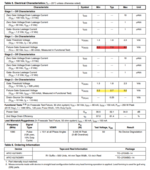mohamis288
Full Member level 3

Hi,
what is the difference between VGG(Q) and VGS? please pay attention to the following datasheet. as you can see, this is a 2-stage power amplifier. please note the page 3 of the datasheet (I have uploaded its picture, as well.) as you can see, VGG(Q) for the first stage is typically 7 volts whereas that one for the second stage is typically 2.7 vols. I have downloaded the large-signal model and as per simulation in ADS, approximately using the same voltage for VGG1(Q) and VGG2(Q) (about 2.4 volts), I have obtained the expected power gain, 32dB. so what is INCORRECT? I apply voltage to the gate of both stage NOT to the gate-source. what is the difference between VGG(Q) and VGS? as per simulation, isn't it correct to write VGS instead of VGG(Q) ?
what is the difference between VGG(Q) and VGS? please pay attention to the following datasheet. as you can see, this is a 2-stage power amplifier. please note the page 3 of the datasheet (I have uploaded its picture, as well.) as you can see, VGG(Q) for the first stage is typically 7 volts whereas that one for the second stage is typically 2.7 vols. I have downloaded the large-signal model and as per simulation in ADS, approximately using the same voltage for VGG1(Q) and VGG2(Q) (about 2.4 volts), I have obtained the expected power gain, 32dB. so what is INCORRECT? I apply voltage to the gate of both stage NOT to the gate-source. what is the difference between VGG(Q) and VGS? as per simulation, isn't it correct to write VGS instead of VGG(Q) ?


